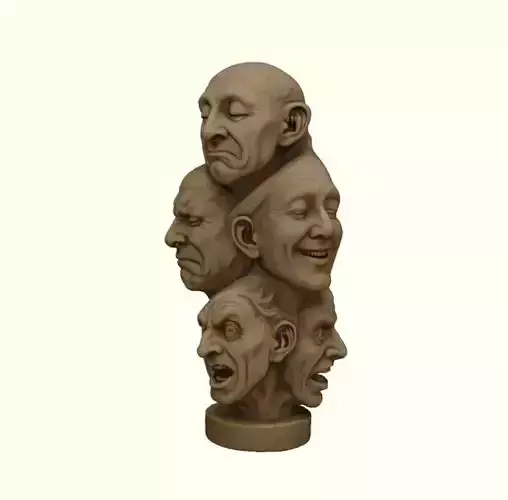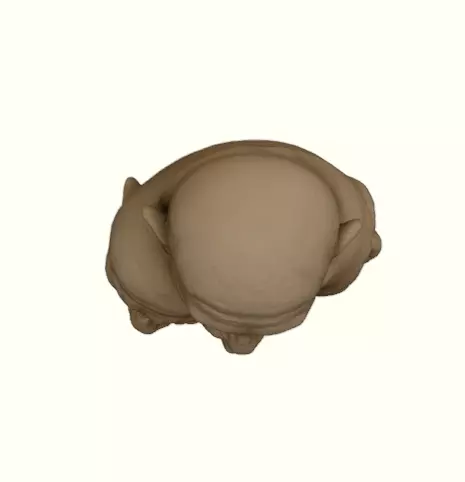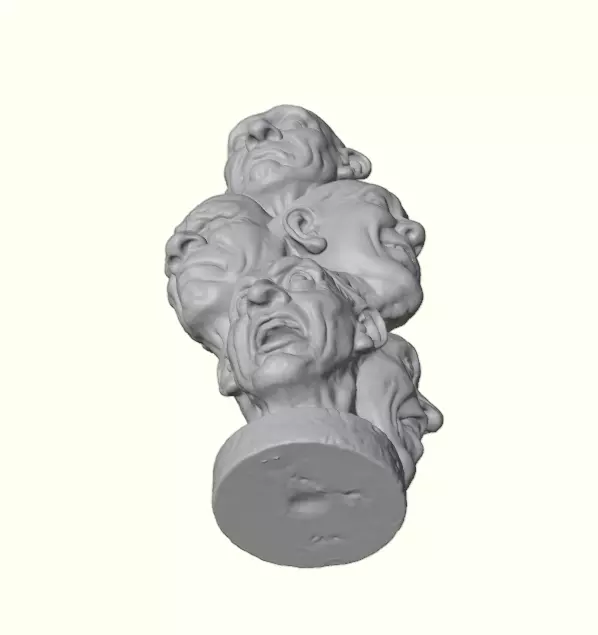
Five Faces of the Mind 3D print model
Emotional Totem Bust
In a quiet workshop, an old sculptor tried to capture the storm inside a human mind. He carved not one head, but many, each locked into a single feeling that refused to fade. Over time the piece became known as the Five Faces of the Mind, a silent totem that seems to watch its owner and reflect what they carry within.
This model represents a tall, cylindrical bust composed of five elderly male faces wrapped around a single column. Each head shows a different strong emotion. One face laughs with relaxed eyes and deep smile lines. Another carries a tired, closed-eyed resignation. A third grimaces with an open mouth and bared teeth, while the remaining profiles show frustration and quiet suffering. The heads flow into one another organically, sharing necks and shoulders that merge into a solid round base for stable printing.
The sculpt focuses on character and anatomy. Wrinkles, folds, ears, eyelids, teeth, and lips are all clearly defined so printers can capture expression even at smaller scales. The overall form works as a psychological art piece for a desk or studio, a prop for tabletop horror or dark fantasy campaigns, or a display bust for painters who want to explore subtle shading across many faces on one model. The neutral base suits monochrome resin prints and full-color textured renders.
This model is based on an original concept and design. The initial 3D form was generated with the assistance of AI tools, after which it was extensively refined and manually detailed in Blender and other 3D editing software. This workflow ensures the figure maintains its unique character and meets the standards of precision, structure, and print-readiness required for high-quality 3D printing.
Please note that the model is primarily designed for textured versions (OBJ + MTL in ZIP archive), which allows for a rich and visually detailed result when used with color-supported 3D printing or digital rendering. The non-textured version (STL, 3MF) may lack some surface details visible in the textured formats.Included formats: STL, OBJ, MTL, 3MF, FBX, BLEND inside a ZIP archive, plus standalone OBJ and STL files for the platform’s 3D viewer.
Technical features and printing recommendations
Recommended print technology:
Resin printers for best capture of wrinkles and facial micro-details.
FDM printers at moderate or larger sizes with carefully tuned settings.
Suggested print settings (resin):
Layer height: 0.05–0.08 mm
Mono LCD printer or equivalent
Standard or tough resin
Hollowing with 2–3 mm wall thickness and drain holes in the base to save material
Suggested print settings (FDM):
Layer height: 0.12–0.16 mm
Nozzle: 0.4 mm
Walls: 2–3 perimeters, infill around 12–18% (gyroid or cubic)
Recommended materials: PLA or ABS, with PETG if you prefer extra toughness
Supports:
Supports required.
Print the model upright on the base.
Enable supports from the build plate and, if needed, from the model for the chins, ears, noses, and overhanging brows.
Add a small brim to improve adhesion for taller prints.
Recommended size:
Ideal display height around 150–180 mm (about 6–7 inches) for both resin and FDM.
The model keeps its character when scaled down, although very small versions reduce readability of fine wrinkles.
Estimated print time and material use (example at ~170 mm height):
Resin: around 7–9 hours, roughly 120–150 ml of resin depending on hollowing and support density.
FDM: around 8–10 hours, roughly 100–130 g of filament depending on infill and slicer settings.
Plan for at least 540 minutes of print time as a safe minimum, along with about 110 g of material or the resin equivalent, then adjust according to your own slicer estimates.
Scaling Note: This model is designed in millimeters (mm). If it appears too small when imported into your slicer, check that your software uses mm units. If needed, scale the model up 100x if the slicer defaults to meters instead. You can freely scale the height to match your collection or terrain, keeping in mind that very small scales reduce facial detail and very large scales increase print time and material consumption.





















